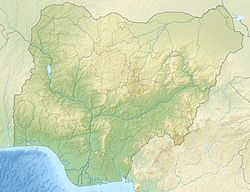Fossil content
edit
Among others, the following fossils have been reported in the formation:[3][4]
Reptiles
edit
Squamates
edit
Invertebrates
edit
Cephalopods
edit
See also
edit
References
edit
- ^ Ogbe, Ovie B.; Osokpor, Jerry (2021-01-01). "Depositional facies, sequence stratigraphy and reservoir potential of the Eocene Nanka Formation of the Ameki Group in Agu-Awka and Umunya, southeast Nigeria". Heliyon. 7 (1): e05846. doi:10.1016/j.heliyon.2020.e05846. ISSN 2405-8440. PMC 7820494. PMID 33521344.
- ^ a b Odumodu, Chukwuemeka; Nfor, Bruno (January 2012). "A New Paratype of an Eocene Nautiloid From the Ameki Formation, Southeastern Nigeria: Implications for Age and Paleoenvironmental Interpretation". Stratigraphy and Sedimentology of Oil-Gas Basins.
- ^ Ameki at Fossilworks.org
- ^ Port Harcourt at Fossilworks.org
- ^ a b c d Andrews, C. W. (December 1919). "A Description of New Species of Zeuglodont and of Leathery Turtle from the Eocene of Southern Nigeria". Proceedings of the Zoological Society of London. 89 (3–4): 309–319. doi:10.1111/j.1096-3642.1919.tb02124.x. ISSN 0370-2774.
- ^ McLeod, Samuel A.; Barnes, Lawrence G. (January 1996). "The Systematic Position of Pappocetus Lugardi and a New Taxon From North America (Archaeoceti: Protocetidae)". The Paleontological Society Special Publications. 8: 270. doi:10.1017/S2475262200002720. ISSN 2475-2622.
- ^ Georgalis, Georgios L. (2023-06-19). "First potential occurrence of the large aquatic snake Pterosphenus (Serpentes, Palaeophiidae) from Nigeria, with further documentation of Pterosphenus schweinfurthi from Egypt". Alcheringa: An Australasian Journal of Palaeontology. 47 (3): 327–335. doi:10.1080/03115518.2023.2217874. ISSN 0311-5518. S2CID 259422068.
Further reading
edit
- Vickers-Rich, Patricia & Rich, Thomas Hewett (1993); Wildlife of Gondwana. Reed. ISBN 0-7301-0315-3
